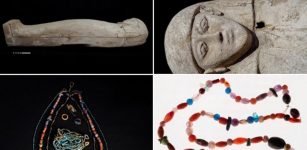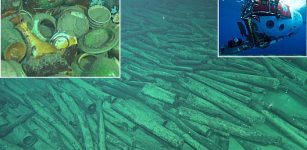Message In A Bottle Thrown Overboard In Germany 132 Years Ago Was Found In Australia
AncientPages.com - A 132-year-old message in a bottle was discovered on a remote Australian beach, Wedge Island and turned out to be part of an important worldwide experiment, reports Deutsche Welle.
An Australian family discovered a bottle half-buried in the sand of tiny Wedge Island, about 140 kilometers (88 miles) north of Perth. Inside was a tightly rolled piece of paper.
"[We] were walking across the dunes when I saw something sticking out of the sand so I went to take a closer look," discoverer Tonya Illman said. "The note was damp, rolled tightly and wrapped with string. We took it home and dried it out, and when we opened it we saw it was a printed form, in German, with very faint German handwriting on it."
More than 130 years ago a German ship threw a message overboard.

Dutch archaeologists said the bottle was a late 1880s gin bottle, ubiquitous throughout Europe and its colonies at the time. Image credit: WA Museum
The bottle was handed to the Western Australian Museum for analysis, who coordinated with German and Dutch agencies to research its history.
The message read:
"This bottle was thrown overboard on June 12, 1886 at latitude 32° 49' South and longitude 105° 25' from Greenwich East.
From: Bark Ship Paula, Port: Elsfleth, Captain: D [illegible], On her journey from Cardiff to Macassar.
The finder is requested to send the slip in the bottle to the German Naval Observatory in Hamburg or the nearest consulate for the return to the same agency after filling in the information on the back.”
The experts determined that the message was genuine.
"Incredibly, an archival search in Germany found Paula's original meteorological journal and there was an entry for June 12, 1886 made by the captain, recording a drift bottle having been thrown overboard. The date and the coordinates correspond exactly with those on the bottle message," Dr Ross Anderson, Assistant Curator Maritime Archaeology at the WA Museum, said in a statement.
German authorities said the bottle was one of thousands thrown overboard during a 69-year-long oceanographic experiment to research global ocean currents and discover more efficient shipping routes.
The bottle likely washed up on the beach six to 12 months later.
The experiments were conducted by German scientist Georg von Neumayer, who became the first Director of the German Naval Observatory in 1876 and was a leading figure in drift bottle research. His worldwide experiment provided valuable data on the great ocean currents.
Some 662 of the messages were returned to Hamburg (about 10 percent), but none of the actual bottles were ever returned. The last time one of the notes was found was in 1934 in Denmark.
Archival records revealed the ship carrying the newly-discovered bottle was most likely transporting Welsh steaming coal. The bottle has been loaned to the museum for two years.
Original story - here.
AncientPages.com
More From Ancient Pages
-
 Ancient People Handled Sun Exposure Better Than Modern People – An Anthropologist Explains Why
Featured Stories | Sep 21, 2022
Ancient People Handled Sun Exposure Better Than Modern People – An Anthropologist Explains Why
Featured Stories | Sep 21, 2022 -
 On This Day In History: Mary Queen Of Scots Was Forced To Abdicate – On July 24, 1567
News | Jul 24, 2016
On This Day In History: Mary Queen Of Scots Was Forced To Abdicate – On July 24, 1567
News | Jul 24, 2016 -
 Mystery Of The Headless Skeletons From Vráble
Archaeology | Apr 4, 2022
Mystery Of The Headless Skeletons From Vráble
Archaeology | Apr 4, 2022 -
 The Seal Of Solomon, The Fifth Element And The Andromeda Constellation Reveal An Intriguing Connection
Ancient Mysteries | Mar 8, 2018
The Seal Of Solomon, The Fifth Element And The Andromeda Constellation Reveal An Intriguing Connection
Ancient Mysteries | Mar 8, 2018 -
 Precious Lost Ancient Book Of Wisdom Could Solve Biblical Mysteries
Ancient Mysteries | Nov 26, 2018
Precious Lost Ancient Book Of Wisdom Could Solve Biblical Mysteries
Ancient Mysteries | Nov 26, 2018 -
 Beautiful Necklaces And Amulets Discovered In Ancient Egyptian Tomb
Archaeology | Apr 27, 2020
Beautiful Necklaces And Amulets Discovered In Ancient Egyptian Tomb
Archaeology | Apr 27, 2020 -
 Ancient Roman Government Structure And The Twelve Tables
Ancient History Facts | Jan 18, 2016
Ancient Roman Government Structure And The Twelve Tables
Ancient History Facts | Jan 18, 2016 -
 Ancient Basilica Cistern: Intriguing Hidden Subterranean World With Medusa Heads
Featured Stories | Dec 11, 2018
Ancient Basilica Cistern: Intriguing Hidden Subterranean World With Medusa Heads
Featured Stories | Dec 11, 2018 -
 Red And Black Ink Used In Egyptian Papyri Reveal Ancient Writing Practices
News | Oct 27, 2020
Red And Black Ink Used In Egyptian Papyri Reveal Ancient Writing Practices
News | Oct 27, 2020 -
 Statue Of Apollo Discovered in Ancient City Of Prusias ad Hypium, Turkey
Archaeology | Aug 26, 2022
Statue Of Apollo Discovered in Ancient City Of Prusias ad Hypium, Turkey
Archaeology | Aug 26, 2022 -
 How Pre-Industrial Communities in Northeastern Europe Adapted to Climate Changes Over the Past Two Millennia
Archaeology | Feb 3, 2025
How Pre-Industrial Communities in Northeastern Europe Adapted to Climate Changes Over the Past Two Millennia
Archaeology | Feb 3, 2025 -
 Never-Before-Seen Structures Of King Herod’s Magnificent Palace Herodium Unveiled
Archaeology | Dec 11, 2020
Never-Before-Seen Structures Of King Herod’s Magnificent Palace Herodium Unveiled
Archaeology | Dec 11, 2020 -
 Angkor Wat: Pre-Industrial City’s Downfall And Climate Change
Archaeology | Apr 18, 2020
Angkor Wat: Pre-Industrial City’s Downfall And Climate Change
Archaeology | Apr 18, 2020 -
 On This Day In History: Knights Templars’ Jacques de Molay Burned At The Stake – On Mar 18, 1314
News | Mar 18, 2017
On This Day In History: Knights Templars’ Jacques de Molay Burned At The Stake – On Mar 18, 1314
News | Mar 18, 2017 -
 Extraordinary Etruscan And Roman Treasure Trove Unearthed In San Casciano dei Bagni, Italy
Archaeology | Aug 12, 2022
Extraordinary Etruscan And Roman Treasure Trove Unearthed In San Casciano dei Bagni, Italy
Archaeology | Aug 12, 2022 -
 Lost Q Source Remains An Unsolved Biblical Mystery
Biblical Mysteries | May 7, 2017
Lost Q Source Remains An Unsolved Biblical Mystery
Biblical Mysteries | May 7, 2017 -
 Ming-Era Two Shipwrecks With 100,000 Ancient Relics Examined By Scientists
Archaeology | May 30, 2023
Ming-Era Two Shipwrecks With 100,000 Ancient Relics Examined By Scientists
Archaeology | May 30, 2023 -
 A 2,000 Year-Old And Rare Chalkstone Vessel Production Center Unearthed Near Nazareth
Archaeology | Aug 18, 2017
A 2,000 Year-Old And Rare Chalkstone Vessel Production Center Unearthed Near Nazareth
Archaeology | Aug 18, 2017 -
 26,000-Year-Old Footprints In Chauvet Cave: Oldest Evidence Of Human-Canine Relationship
Featured Stories | Dec 29, 2016
26,000-Year-Old Footprints In Chauvet Cave: Oldest Evidence Of Human-Canine Relationship
Featured Stories | Dec 29, 2016 -
 Ancient DNA Reveals The Earliest Evidence Of The Last Massive Human Migration To Western Europe
DNA | Jul 24, 2023
Ancient DNA Reveals The Earliest Evidence Of The Last Massive Human Migration To Western Europe
DNA | Jul 24, 2023


